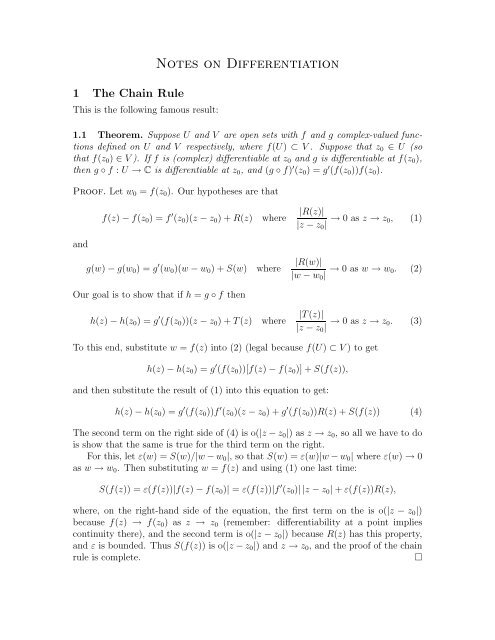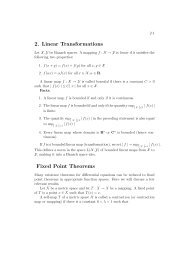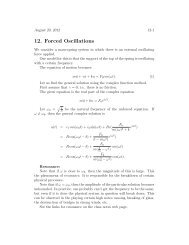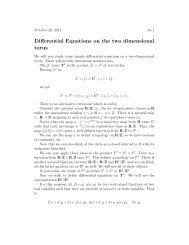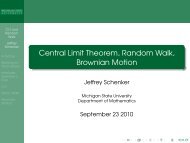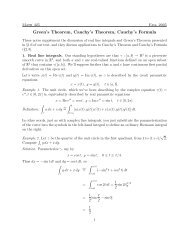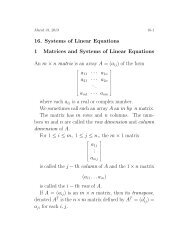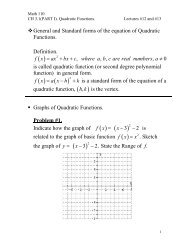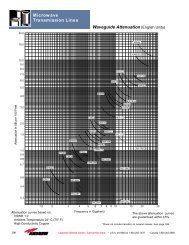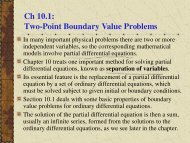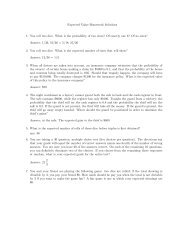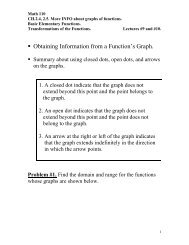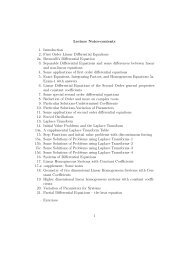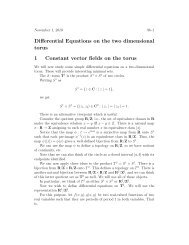Notes on Differentiation - Michigan State University
Notes on Differentiation - Michigan State University
Notes on Differentiation - Michigan State University
Create successful ePaper yourself
Turn your PDF publications into a flip-book with our unique Google optimized e-Paper software.
Math 829 Spring 19992.2 Exercise. Define “differentiable” for real-valued functi<strong>on</strong>s defined <strong>on</strong> open subsetsof R n . <strong>State</strong> and prove a sufficient c<strong>on</strong>diti<strong>on</strong> for differentiability of such functi<strong>on</strong>sthat generalizes Theorem 2.1.3 The “cosmic truth” about differentiati<strong>on</strong>Suppose U is an open subset of R n , and that f : U → R m .3.1 Definiti<strong>on</strong>. We say that f is differentiable at a point p 0 of U if there is alinear transformati<strong>on</strong> T : R n → R m such thatf(p 0 + h) =f(p 0 )+Th+ R(h) ∀h ∈ R n sufficiently close to p 0 , (6)where |R(h)| =o(|h|) as|h| →0inR n .3.2 Notati<strong>on</strong>. If f is differentiable at p 0 then the linear transformati<strong>on</strong> T in theabove definiti<strong>on</strong> is called the derivative of f at p 0 . We will write T = Df(p 0 ),preferring (almost always) to reserve the “prime” notati<strong>on</strong> for the complex derivative.3.3 Exercises. You should go back to the definiti<strong>on</strong> of differentiability for functi<strong>on</strong>sR 2 → R and identify this linear transformati<strong>on</strong>. Do the same for functi<strong>on</strong>s from anopen subset of R n to R. Do the same for differentiable functi<strong>on</strong>s from intervals ofthe real line to R 2 , or more generally R n (the so-called “vector-valued functi<strong>on</strong>s).Finally, how do you fit the definiti<strong>on</strong> of “complex differentiability” into this “lineartransformati<strong>on</strong>” c<strong>on</strong>text?3.4 Exercise. If f is differentiable at p 0 then f is c<strong>on</strong>tinuous at p 0 .3.5 The matrix of Df(p 0 ). Let {e 1 ,e 2 ,...e n } be the standard unit vector basisfor R n (i.e., e j is the vector with 1 in the j-th positi<strong>on</strong> and zeros elsewhere). Thenup<strong>on</strong> fixing j and substituting h = te j into (6) and letting t → 0, an argument entirelysimilar to the <strong>on</strong>e we used in class for the case n =2,m= 1 shows thatTe j = ∂f∂x j(p 0 )=( ∂f1∂x j(p 0 ),... , ∂f m∂x j(p 0 )where f j : U → R is the j-th coordinate functi<strong>on</strong> of f:f =(f 1 ,f 1 ,... ,f n ).Thus the matrix of Df(p 0 ) with respect to the standard bases in R n and R m respectivelyis the <strong>on</strong>e whose j-th column is ∂f∂x j(p 0 ) (written as a column vector, ratherthan as the usual row vector). Let’s call this matrix [Df(p 0 )]. Thus [Df(p 0 )] =[ ∂f i∂x j(p 0 )] m,ni=1,j=1 . The image Df(p 0)h of a vector h ∈ R n is the m-dimensi<strong>on</strong>al vectorfound from the equati<strong>on</strong>[Df(p 0 )h] =[Df(p 0 )][h],-3-),
Math 829 Spring 1999where square brackets around a vector denote the corresp<strong>on</strong>ding column matrix, i.e.the transpose of the original (row) vector.3.6 The Chain Rule revisited. Now suppose that, in additi<strong>on</strong> to the setup above,V is an open subset of R m c<strong>on</strong>tained in f(U), and g : V → R p is differentiable atf(p 0 ). Then g ◦ f : U → R p is differentiable at p 0 , andD(g ◦ f)(p 0 )=(Dg)(f(p 0 ))Df(p 0 )where the product between the derivatives <strong>on</strong> the right is the product of linear lineartransformati<strong>on</strong>s, i.e. their compositi<strong>on</strong>.3.7 Exercise. Adopt the argument of §1 to prove this versi<strong>on</strong> of the Chain Rule.Suggesti<strong>on</strong>: If you make a suitable definiti<strong>on</strong> of the norm |T | of a linear transformati<strong>on</strong>,say|T | = max{|Tx| : x ∈ R n , |x| =1},then the maximum in questi<strong>on</strong> exists (and is finite) because the map x →|Tx| isa c<strong>on</strong>tinuous real-valued functi<strong>on</strong> <strong>on</strong> the (compact) unit sphere of R n , and you caneasily prove that|Tx|≤|T ||x| ∀x ∈ R n , (7)From this you should be able to write down a proof of the chain rule that is almostword-for-word the same as the <strong>on</strong>e in §1. If you want a more c<strong>on</strong>cretely defined normfor linear transformati<strong>on</strong>s you can take |T | to be the square root of sum of the squaresof the entries of [T ], a quantity that is, in general, larger than the previously definednorm. For this <strong>on</strong>e the Cauchy-Schwarz inequality gives (7).3.8 Corollary Suppose that:• f : U → R m is differentiable at at each point of an open set U ⊂ R n ,• I is an open interval of the real line, and• γ : I → R n is a differentiable functi<strong>on</strong> with γ(I) ⊂ U.Suppose t 0 ∈ I, v is a n<strong>on</strong>zero vector in R n that is tangent to the curve γ at γ(t 0 ).Then Df(γ(t 0 ))γ(t 0 ) is a vector tangent to the image-curve f ◦ γ at f(γ(t 0 )) (as l<strong>on</strong>gas this vector is n<strong>on</strong>zero).Proof. A tangent vector to a curve γ at <strong>on</strong>e of its points γ(t 0 ) is just γ ′ (t 0 ), which youcan think of as a vector (with coordinates equal to the derivatives of the coordinatefuncti<strong>on</strong>s). (As a linear transformati<strong>on</strong> R → R n , this derivative would just be themap that takes h ∈ R to h times the tangent vector.) With this in hand, the Corollarybecomes a restatement of the Chain Rule—try it!□-4-
Math 829 Spring 19994.3 Analytic statement of the problem. It’s pretty clear that the stereographicprojecti<strong>on</strong> preserves the sense of angles, so we will c<strong>on</strong>centrate <strong>on</strong> preservati<strong>on</strong> ofmagnitudes of angles. Here is the analytic expressi<strong>on</strong> of what needs to be d<strong>on</strong>e.Suppose p ∈ S 2 \{N} and v, w ∈ R 3 with〈p, v〉 =0 and 〈p, w〉 =0, (9)(i.e. v and w are orthog<strong>on</strong>al to the line from the origin to p, and hence tangent to S 2at p). Let A =[Dσ(p)], the matrix of Df(p) with respect to the standard basis. Wedesire to show that〈Av, Aw〉|Av||Aw|=〈v, w〉|v||w| . (10)The quantities that show up <strong>on</strong> the left and right hand sides of this last equati<strong>on</strong>are, you will recall, the cosines of the angles between the respective pairs of vectors 1 .4.4 Exercise—reducti<strong>on</strong> of problem. Show that in order to prove (10) you need<strong>on</strong>ly show that there is a positive c<strong>on</strong>stant c such thatfor all v, w ∈ R 3 satisfying (9).In order to prove (11) we observe that〈Av, Aw〉 = c〈v, w〉 (11)〈Av, Aw〉 = 〈A ∗ Av, w〉where A ∗ is the linear transformati<strong>on</strong> R 2 → R 3 whose matrix is the transpose of thematrix of A. This is just a matrix calculati<strong>on</strong> based <strong>on</strong> the fact that 〈x, y〉 =[x] T [y](matrix product), where x and y are any vectors in the same Euclidean space, [x]and [y] are their respective column vectors, and the superscript “T ” denotes matrixtranspose. Thus:〈Aw, Av〉 = [Aw] T [Av] =([A][w]) T [A][v]= [w] T [A] T [A][v] =[w] T [A ∗ A][v]= 〈w, A ∗ Av〉from which the desired result follows by the symmetry of the inner product (it isunchanged if the order of its entries is reversed). Note that this calculati<strong>on</strong> works aswell for any m × n matrix and any pair of vectors in R n .1 Remember that the inner product <strong>on</strong> the left-hand side of the equati<strong>on</strong> is the <strong>on</strong>e for R 3 , andthe <strong>on</strong>e <strong>on</strong> the right is that of R 2 .-6-


